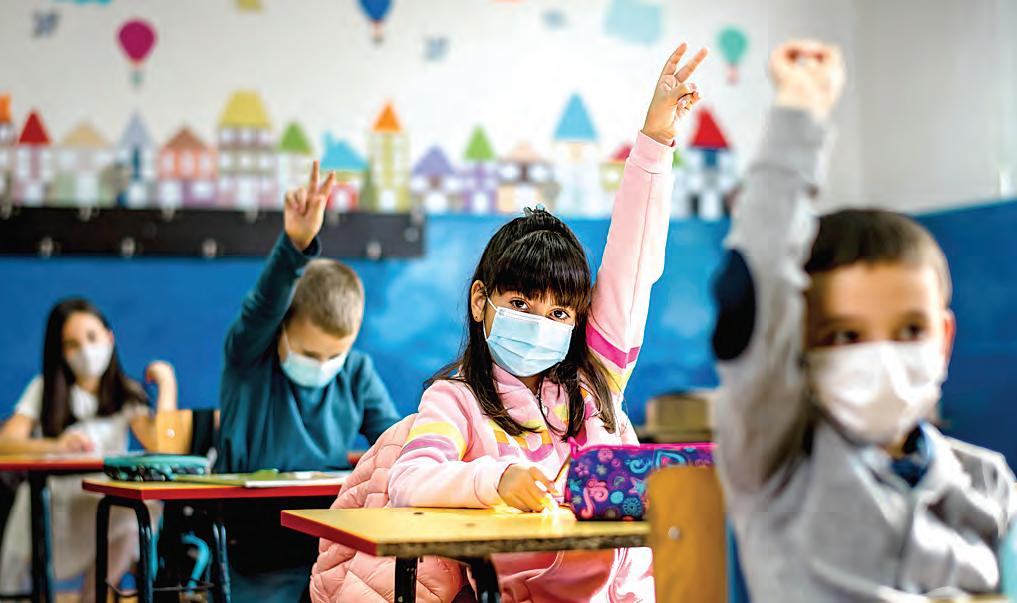
5 minute read
The latest in planning for school
School return hinges on vaccine
by Max Parrott
Associate Editor
In just over two weeks, New York City’s public school system is planning a full in-person reopening for its nearly 1.1 million students for the first time since it went remote before the pandemic.
Mayor de Blasio, who has touted the school system’s low transmission rate during its hybrid reopening last year and called the Department of Education’s Covid response the “gold standard of health and safety measures,” has maintained that the reopening will go according to plan. In spite of the mayor’s insistence, the Delta variant’s surge in cases has become cause for concern for some parents and educators as schools near the first day.
The school system will continue with many of the Covid safety protocols in place that kept the rate of infection down like ventilation, cleaning and mandatory mask wearing.
While the city has been rolling out schoolrelated announcements, there remain several large policy details that the administration will have to address in the following weeks regarding the testing of students and staff and how those who test positive will have to quarantine.
Vaccinations
When announcing that schools would fully return in May, de Blasio said that the city’s vaccination efforts played a central role in the decision. Since then he has continued to insist that a high vaccination rate among staff and eligible students is critical for the return.
Though de Blasio said as recently as Monday that making vaccination mandatory for all students is not on the table, he did make it a requirement for all DOE staff, ranging from teachers and principals to custodians and food service workers, to have received at least one dose of the Covid vaccine by Sept. 27.
At least 63 percent of DOE employees were vaccinated as of Monday, according to Schools Chancellor Meisha Ross Porter.
The rate for all children under 18 is 18 percent in New York City, given that the vaccine is still unavailable for children under 12. As of last week, around 300,000 12- to-17-yearolds have gotten at least one dose, around half New York City’s population in that age range. The city has been rolling out pop-up vaccination sites at public schools participating in Summer Rising, the city’s summer school program, in an attempt to boost those rates in the remaining time before school. As an added incentive, last week the DOE added a requirement that public school athletes will need a vaccine to play several high-risk school sports — a policy that will affect roughly 20,000 students and staff participating in athletics including football and volleyball in the fall and more in the winter and spring.
Social distancing
Though a majority of schools will have no trouble abiding by the CDC’s guidance to maintain at least 3 feet of guidance, reports from electeds and union officials indicate that some will struggle to meet that standard.
While the CDC guidelines for opening K-12 schools make a 3-foot-distancing suggestion, they stop short of making it a requirement, emphasizing that a safe return to in-person learning takes priority over all individual cases.
As in last year’s reopening principals will have to work with each school’s unique spatial constraints to create a plan that works for them. The DOE said it has continued to work with principals to develop workarounds like making cafeteria and meal service flexible in
Questions remain on reopening
order to make the space available at various points during the day or utilizing outdoor space. United Federation of Teachers President Michael Mulgrew has said that the DOE has reported it was able to meet the 3-foot guidance for all but 50 schools citywide, but added that he was skeptical of that figure.
In Queens, which has the largest share of overcrowded schools in the city, the challenge of finding creative solutions is especially difficult. Community Education Council 26 President Adriana Aviles said she doesn’t know how Fresh Meadows’ Francis Lewis High School, one of the city’s most overcrowded schools, is going to organize its full return.
Forest Hills parent and Community Board 6 Education Committee Chairwoman Heather Beers-Dimitriadis said that she’s been hearing that cafeteria constraints are forcing schools to get creative. She told the Chronicle that one of her daughters who is going to Frank Sinatra School of the Arts High School, has the flexibility of eating on the roof of the relatively new building. Her other daughter, who is going to a smaller school in Manhattan, has been given the option to go buy her lunch off school premises and bring it back inside.


The Department of Education has rolled out vaccination sites aimed at students over the summer but inoculations remain unavailable for those under 12.
Quarantine concerns
Some of the biggest remaining questions of what the reopening will look like revolve around protocols over testing and quarantining. Last school year, classroom and building closures became highly contentious, when two unrelated positive cases could result in closed schools.
The city has yet to determine both what
triggers a class- or schoolwide quarantine and how students participate when they’re at home. De Blasio has responded by saying that closures are going to be much less widespread than in the previous year because of the rate of vaccination, but has yet to make many details clear. What we do know is that fully vaccinated students and staff will not have to quarantine unless they test positive for the virus or begin to “ exhibit symptoms if someone in their classroom tests posiIf kids have to quarantine for tive for Covid when schools reopen in 10 days, then what will the fall. Rego Park parent meaningful instruction look and head of the like and who is responsible? Queens Parents United group Jean Hahn found the pro” tocol regarding school closures overly conservative
COUNCILMAN MARK TREYGER last year. She said that she is worried that a randomized, mandatory testing regimen like the DOE imposed last year could lead to widespread closures that would disrupt learning. As parents anxiously await the city’s guidance on Covid outbreaks, remote learning has stayed a hot topic. Though de Blasio has consistently ruled out a remote option, some parent groups demanded that he change course on the issue. City Council Education Chairman Mark Treyger (D-Brooklyn) wrote a letter urging Porter to consider a remote learning option for students who are immunocompromised or too young to be vaccinated. “If kids have to quarantine for 10 days, then what will meaningful instruction look like and who is responsible?” wrote Treyger in the Aug. 19 letter, which was signed by 28 councilmembers. Some educators, on the other hand, have questioned how a remote option could work on a practical level. Q









